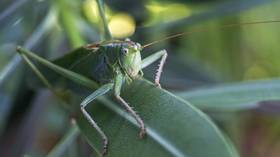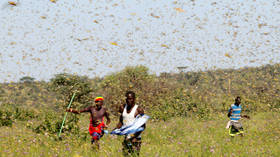https://www.rt.com/news/478137-grasshoppers-plane-landing-divert/
LIVE
HomeWorld News
Huge swarm of grasshoppers splatter plane cockpit, force pilots to abandon landing and divert (PHOTOS)
13 Jan, 2020 14:41 / Updated 1 month ago

File photo © GlobalLookPress/imageBROKER.com/Harry Laub

An Ethiopian Airlines flight from Djibouti was forced to divert after running afoul of an enormous swarm of grasshoppers mid-air, splattering the engines and cockpit with insects and seriously hampering the pilots’ visibility.
The initial encounter on January 9 was light enough that the pilots decided to continue on to their destination of Dire Dawa, but then hit a second and much heavier volley of the insects, according to local reports.
The crew tried landing at their destination twice with an insect-splattered windshield, before abandoning the airspace to the grasshoppers and diverting to Addis Ababa, where the flight landed safely some 30 minutes later. Photos of the aircraft show how much the pilots’ visibility was reduced after the grasshopper strike.
The UN’s Food and Agriculture Organization recently issued an alert about major locust and grasshopper invasions in the Horn of Africa.
ALSO ON RT.COM
https://www.rt.com/news/479938-horde-locusts-saudi-arabia/
story with this clean and simple app that delivers the latest headlines to you.
RT
LIVE
HomeWorld News
WATCH: Horde of locusts blocks out the skies in Saudi Arabia, Yemen
3 Feb, 2020 10:14 / Updated 14 days ago
twitter @Hamad21120812
twitter @Hamad21120812

Residents in Saudi Arabia and Yemen have been faced with the bewildering sight of a truly gargantuan swarm of roughly 360 billion locusts, which can block out the sun at times. But an even bigger swarm is coming soon.
The massive locust swarm measures roughly the size of Manhattan and has caused tens of millions of dollars worth of damage, devastating East Africa in one of the worst outbreaks in decades.
Saudi Arabia’s Ministry of Environment has warned residents not to eat any of the locusts as they are likely contaminated with toxic pesticides.
“A swarm the size of Rome can eat enough food in one day as everybody in Kenya," said Keith Cressman, FAO’s senior agriculture officer.
To make matters even worse, another, even larger swarm is expected in April, which could grow up to 500 times in size by June.
ALSO ON RT.COMHuge swarm of grasshoppers splatter plane cockpit, force pilots to abandon landing and divert (PHOTOS)
Think your friends would be interested? Share this story!
https://www.rt.com/news/480558-twin-locust-infestation-hindustan/
story with this clean and simple app that delivers the latest headlines to you.
RT
LIVE
HomeWorld News
India, Pakistan should brace for ‘TWIN INVASION’ of locusts from Horn of Africa & Iran, UN warns
11 Feb, 2020 08:50 / Updated 6 days ago

FILE PHOTO: A swarm of desert locusts flying over a grazing land in Kenya. ©REUTERS / Njeri Mwangi

Giant swarms of locusts may descend on both sides of the India-Pakistani border around spring-summer this year, a UN locust monitor said, amid an unprecedented plague already affecting the black continent.
Gargantuan tribes of desert locusts have been terrifying the residents of Yemen and Saudi Arabia and laying waste to countries in the Horn of Africa. UN’s Food and Agriculture Organization (FAO) calls the outbreak worst in 25 years for the Eastern Africa and worst Kenia in particular faces in 70 years.
After multiplying in the Horn of Africa, the swarms may migrate to Hindustan, where they may deliver a twin strike together with freshly hatched locust from southern Iran, FAO's Senior Locust Forecasting Officer Keith Cressman told IANS news agency on Monday.
ALSO ON RT.COMWATCH: Horde of locusts blocks out the skies in Saudi Arabia, Yemen
“There is a potential risk that the swarms can move from the Horn of Africa, starting in about mid-May until about some time in July to meet those monsoon rains that arrive in Rajasthan in India and Cholistan-Tharparkar in Pakistan,” he said.
The worst-case scenario would require an early breeding season for locusts in Iran, which may be caused by warm weather and plentiful rains. The conditions in the Horn of Africa are currently favorable for fast replication of the pests, which is causing the ongoing infestation in the first place. If they remain as good for the insects, migration to India and Pakistan, which has not happened for quite some time, is likely this year, the official said.
Desert locus is among the most dangerous pests. A 2-gram adult insect is capable of eating its weight worth of food in a day while a swarm usually consists of several tens of millions. They can also fly as far as 150 km in a day after eating crops in a particular area. No wonder a locust infestation is mentioned as one of the Biblical plagues in Exodus.
LIVE
- search
- Menu mobile
HomeWorld News
Huge swarm of grasshoppers splatter plane cockpit, force pilots to abandon landing and divert (PHOTOS)
13 Jan, 2020 14:41 / Updated 1 month ago

File photo © GlobalLookPress/imageBROKER.com/Harry Laub
- 40

An Ethiopian Airlines flight from Djibouti was forced to divert after running afoul of an enormous swarm of grasshoppers mid-air, splattering the engines and cockpit with insects and seriously hampering the pilots’ visibility.
The initial encounter on January 9 was light enough that the pilots decided to continue on to their destination of Dire Dawa, but then hit a second and much heavier volley of the insects, according to local reports.
The crew tried landing at their destination twice with an insect-splattered windshield, before abandoning the airspace to the grasshoppers and diverting to Addis Ababa, where the flight landed safely some 30 minutes later. Photos of the aircraft show how much the pilots’ visibility was reduced after the grasshopper strike.
Big swarms of insects pose a range of safety concerns for aircraft, as they can block up engine parts and seriously limit pilot visibility.طائرة #الخطوط_الأثيوبية ، رحلة ET363# ، من نوع B737-700 تصطدم بأسراب الجراد أثناء الهبوط التدريجي لمطار ديرداوا قادمة من جيبوتي. قائد الطائرة قرر المواصلة والهبوط بسلام #اخبار_الطيران ✈️pic.twitter.com/YsyvlIAWmj
— عشاق عالم الطيران (@AviationWG) January 12, 2020
The UN’s Food and Agriculture Organization recently issued an alert about major locust and grasshopper invasions in the Horn of Africa.
ALSO ON RT.COM
https://www.rt.com/news/479938-horde-locusts-saudi-arabia/
story with this clean and simple app that delivers the latest headlines to you.
RT
LIVE
- search
- Menu mobile
HomeWorld News
WATCH: Horde of locusts blocks out the skies in Saudi Arabia, Yemen
3 Feb, 2020 10:14 / Updated 14 days ago
twitter @Hamad21120812
twitter @Hamad21120812
- 569

Residents in Saudi Arabia and Yemen have been faced with the bewildering sight of a truly gargantuan swarm of roughly 360 billion locusts, which can block out the sun at times. But an even bigger swarm is coming soon.
The massive locust swarm measures roughly the size of Manhattan and has caused tens of millions of dollars worth of damage, devastating East Africa in one of the worst outbreaks in decades.
Horde of locusts swarm #SaudiArabia, many more insects yet to comeSTORY: https://t.co/QN1fttU7z8pic.twitter.com/rU1bLMRApG
— RT (@RT_com) February 4, 2020
The Food and Agriculture Organisation (FAO) of the United Nations has requested over $75 million to tackle the emerging crisis caused by the swarm. The insect outbreak was itself triggered by a series of recent cyclones, which produced ideal breeding conditions for the pests.
Saudi Arabia’s Ministry of Environment has warned residents not to eat any of the locusts as they are likely contaminated with toxic pesticides.
Desert locusts consume their own bodyweight in food each day, and can travel up to 150km in swarms large enough to block out the sun.جانب من أعمال إدارة الصحة العامة بوكالة الخدمات ، للحد من التلوث ومكافحة الحشرات ، داخل المدينة.#أمانة_منطقة_نجرانpic.twitter.com/4NuMkMMklN
— أمانة منطقة نجران (@NajranMunicipal) May 5, 2019
“A swarm the size of Rome can eat enough food in one day as everybody in Kenya," said Keith Cressman, FAO’s senior agriculture officer.
To make matters even worse, another, even larger swarm is expected in April, which could grow up to 500 times in size by June.
ALSO ON RT.COMHuge swarm of grasshoppers splatter plane cockpit, force pilots to abandon landing and divert (PHOTOS)
Think your friends would be interested? Share this story!
- 569
https://www.rt.com/news/480558-twin-locust-infestation-hindustan/
story with this clean and simple app that delivers the latest headlines to you.
RT
LIVE
- search
- Menu mobile
HomeWorld News
India, Pakistan should brace for ‘TWIN INVASION’ of locusts from Horn of Africa & Iran, UN warns
11 Feb, 2020 08:50 / Updated 6 days ago
FILE PHOTO: A swarm of desert locusts flying over a grazing land in Kenya. ©REUTERS / Njeri Mwangi
- 207

Giant swarms of locusts may descend on both sides of the India-Pakistani border around spring-summer this year, a UN locust monitor said, amid an unprecedented plague already affecting the black continent.
Gargantuan tribes of desert locusts have been terrifying the residents of Yemen and Saudi Arabia and laying waste to countries in the Horn of Africa. UN’s Food and Agriculture Organization (FAO) calls the outbreak worst in 25 years for the Eastern Africa and worst Kenia in particular faces in 70 years.
After multiplying in the Horn of Africa, the swarms may migrate to Hindustan, where they may deliver a twin strike together with freshly hatched locust from southern Iran, FAO's Senior Locust Forecasting Officer Keith Cressman told IANS news agency on Monday.
ALSO ON RT.COMWATCH: Horde of locusts blocks out the skies in Saudi Arabia, Yemen
“There is a potential risk that the swarms can move from the Horn of Africa, starting in about mid-May until about some time in July to meet those monsoon rains that arrive in Rajasthan in India and Cholistan-Tharparkar in Pakistan,” he said.
The worst-case scenario would require an early breeding season for locusts in Iran, which may be caused by warm weather and plentiful rains. The conditions in the Horn of Africa are currently favorable for fast replication of the pests, which is causing the ongoing infestation in the first place. If they remain as good for the insects, migration to India and Pakistan, which has not happened for quite some time, is likely this year, the official said.
Iranian locusts hit Pakistan and India the previous year. Cressman said he hoped the two nations are better prepared than countries like Somalia or Ethiopia to deal with the swarms. African nations lack security and funding to control and contain the plague that may soon seriously affect South Sudan, Uganda and Tanzania, according to FAO. The region is already suffering from food insecurity, so the crisis may lead to serious starvation.[It] is due to the large concentration of locusts that are currently present in Kenya, Somalia and Ethiopia, and the possibility for them to increase further in number in the next six months between now and June so they can increase up to 400 times than we have now.
Desert locus is among the most dangerous pests. A 2-gram adult insect is capable of eating its weight worth of food in a day while a swarm usually consists of several tens of millions. They can also fly as far as 150 km in a day after eating crops in a particular area. No wonder a locust infestation is mentioned as one of the Biblical plagues in Exodus.
